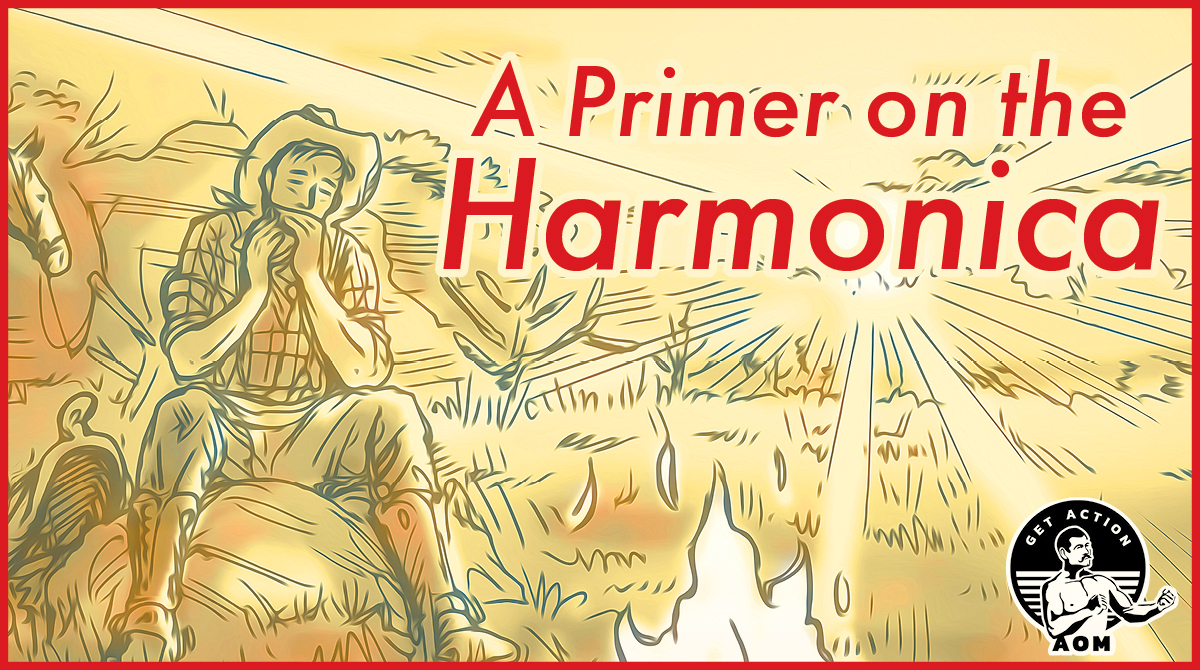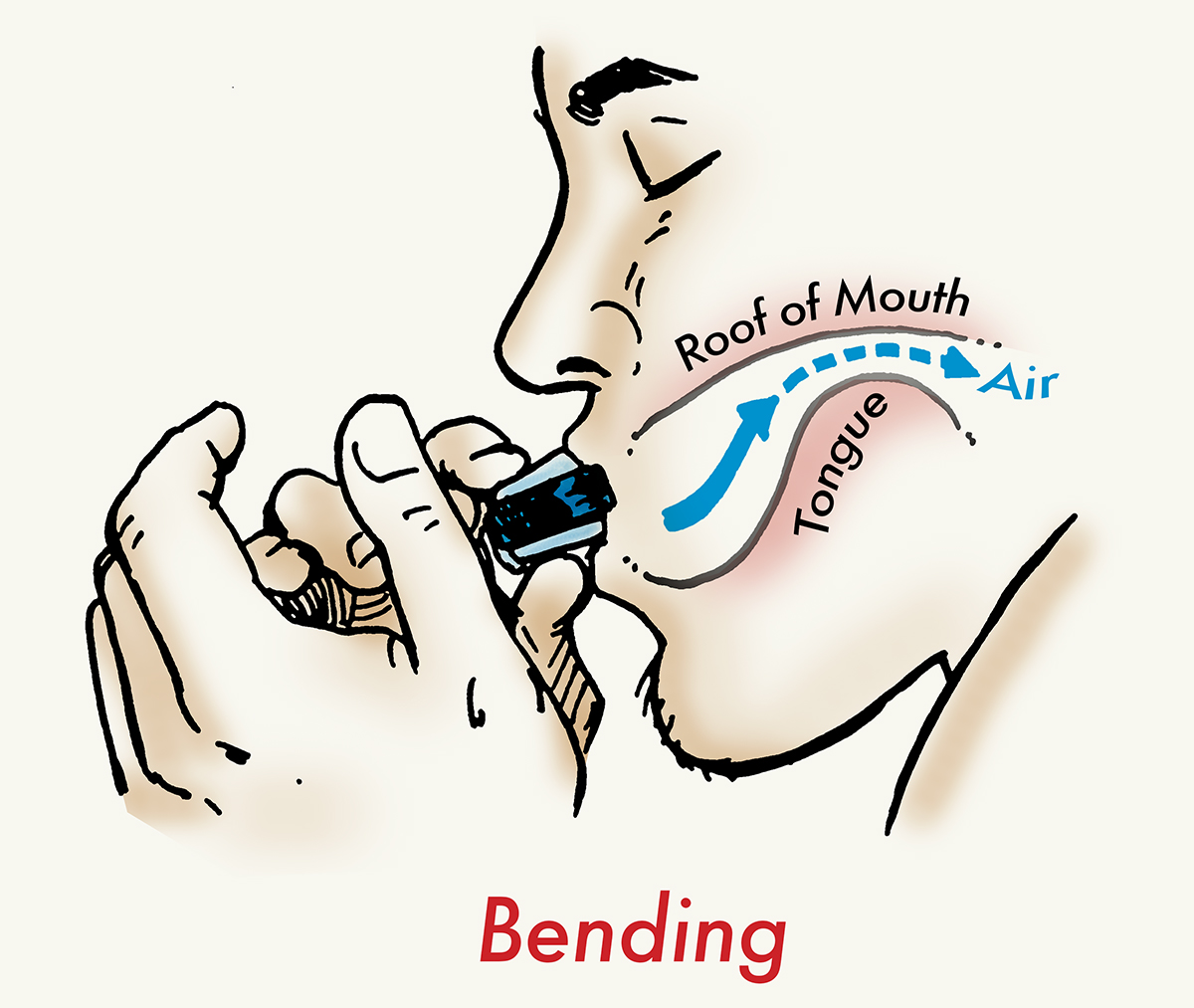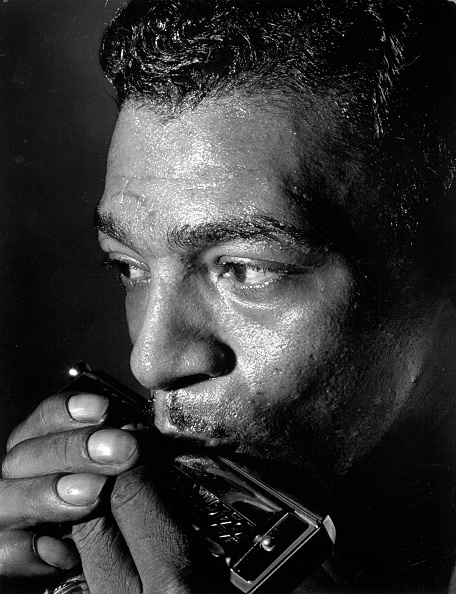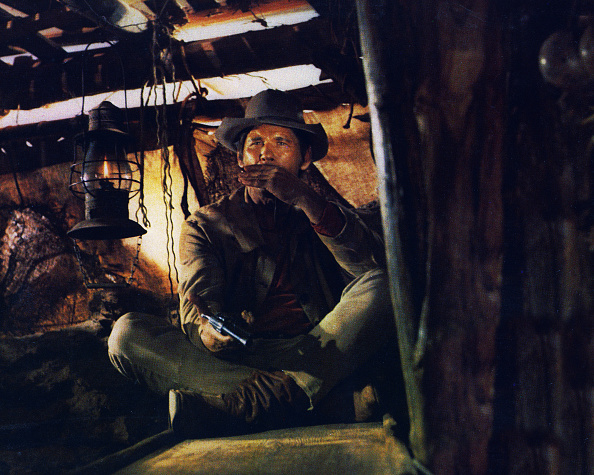
Editor’s note: This is a guest article from professional harmonica player Connor Frontera.
In the Old West, a smart cowboy was never without his gun, if he had any sense about him. If he found himself in the wilderness, it was pretty rare you’d find him without his harmonica, either. Seated by the fireside with his friends or alone with his trusty horse, the harmonica provided an excellent musical accompaniment to life on the range.
Without a doubt, the harmonica is one manly instrument: affordable and portable, it entraps an entire world of music within a little “tin sandwich.”
Unfortunately, too many people dismiss the harmonica as not being a “real†musical instrument (I know from experience), jokingly associating it with jail, people’s grandfathers, or a toy you stick in a child’s Christmas stocking. In truth, there is much more to it than commonly meets the eye. The harmonica possesses a quality of secrecy, which is why so little about it is really known. Everything happens inside the mouth, and it utilizes an infrequently used muscle, the tongue, to create notes and achieve the best tone.
This article aims to answer some questions about the ubiquitous yet mysterious harmonica, give a brief introduction to this small albeit epic instrument, and add a little more musical manliness to your list of everyday carry items.
A Very Brief History of the Harmonica
The harmonica is derived from an ancient Chinese instrument called the sheng. The sheng is the oldest known instrument that uses free reeds (thin, flexible strips of metal) to produce notes. The harmonica produces its sound the same way, and was invented by a man named Christian Buschmann in 1821; soon after, a man named Joseph Richter standardized the tuning.
Although there is no concrete historical evidence of how its popularity grew, the harmonica was floating around America at the tail end of slavery, and most likely got into the hands of poor African Americans because it was small and concealable. Similarly, cowboys began toting them around because of their size.
In no time, the harmonica became an iconic American instrument. By the 1930s, harmonicas were everywhere in the United States. Since they were so affordable, everyone played one or knew someone who played one. Entire harmonica bands were formed all over the country. It was a harmonica craze and harmonica players flourished. As more years passed, African Americans were able to express themselves more openly, creating a genre of music called the “blues,†in which the harmonica frequently showed up.
Since its conception in 19th century Germany, the harmonica has provided countless hours of entertainment and has traveled across the world and the cosmos (being the first instrument to be played in outer space).
The Parts of a Harmonica

My antique Marine Band harmonica; you can clearly see all the pieces of the instrument.
Every harmonica consists of three main parts: the cover plates, the reed plates, and the comb.
Cover plates. The cover plates of a harmonica are the pieces of metal that rest on the top and bottom of the harmonica. These are usually decorated with a logo. The top cover plate almost always has numbers on it, corresponding to the holes you blow in and draw from.
Reed plates. The reed plates are the plates of metal under the cover plates. This is where the sound comes from. They are usually made from brass but some companies use other metals as well.
Comb. The comb is in the center of the harmonica, holding everything together with either screws or nails. It looks exactly like a hair comb, which is where it gets its name.
Some harmonicas have additional parts, such as slides, windsavers, and valves. They usually take more knowledge to play and incorporate more music theory.
Types of Harmonicas
There are five main types of harmonicas: diatonic, chromatic, chord, bass, and specialty. Each type has a specific use, and players usually find which type is the most suited for them after becoming acquainted with each. Although diatonic is the most popular (and most affordable), all serious harmonica players should eventually play and own all five types if they want to be proficient. Beginners usually start with either the diatonic or chromatic. For the purposes of this article, the diatonic will be chosen as the explanatory model.
The diatonic harmonica is an instrument that has ten holes, each being able to play a note on the blow and the draw. Because of this design, not all of the notes in the chromatic scale are available on a diatonic harmonica, although there are some advanced techniques to unlock them. In short, a diatonic harmonica is limited in the number of notes it can play in a beginner’s hand, but that does not mean it cannot make amazing music. Much of the best harmonica music can be played within the boundaries of this instrument.
Which Diatonic?
As a new player, you want to begin by purchasing a standard diatonic harmonica in the key of C. There are many different brands, but the top three are Hohner, Suzuki, and Seydel. Here are some models to consider:
- Hohner Special 20. This is a very good entry level choice.
- Hohner Marine Band. This is the iconic blues harmonica. It plays well, but has nails instead of screws to hold it together, making it difficult to take apart and reassemble.
- Hohner Golden Melody. An excellent harmonica for melodies, and specifically country and gospel music.
- Suzuki Manji. Suzuki’s flagship diatonic. These are high quality harmonicas and were played by Jason Ricci (one of history’s greatest harmonica players) for some time.
- Seydel 1847. Seydel’s bread and butter. Very good harmonica, but it costs more than twice what the others do. The reeds are made out of stainless steel, which last longer than traditional brass reeds.
For anyone who is curious, I play Marine Bands, Golden Melodies, and Rockets (all made by Hohner).
There are other, more affordable brands, notably Golden Bird and Easttop, though they’re a half-step down in quality. I endorse Golden Bird harmonicas and highly recommend them. If you begin liking the harmonica and want to get different keys to explore the range of sounds without breaking the bank, this is the best way to do it.
The Harmonica Layout
Every diatonic and chromatic harmonica has a key, which means that the holes are organized in a pattern that corresponds to the notes in that key’s scale. As you learn more about theory, you will understand exactly what the patterns are, but for now, we’ll keep it simple. The notes are organized in a repeating major scale with some slight deviations. Basically, the diatonic harmonica can only play notes in the major scale of that key with blowing and drawing. The layout of a diatonic harmonica in the key of C looks like this:

Think about it like this: if you start on a C note on a piano and play alphabetically (the white keys) all the way up to the next C note, you get the exact same layout as the harmonica. To get the other notes (or black keys), you would have to use a technique called bending, which will be discussed later in this article.
Before You Play
A couple things to bring to your attention before even sounding a note:
Posture. Posture is very important when playing the harmonica. Keeping a straight back, while either standing or sitting, will make it easier to play, giving you a better tone and more control of the air going in and out of your lungs.

Holding/Cupping. To achieve the best possible acoustic tone, there is a special way to hold the harmonica. Using your left hand (with the numbers on the top cover plate), make a good ol’ fashioned hand puppet. Now stick the harmonica all the way in the hand puppet’s mouth.
Then the right hand needs to create a chamber to deepen the sound and give the harmonica some tone. To do this, slightly cup the right hand and place it behind the left hand. Now you have your proper cupping technique. The right hand can be rapidly moved on and off to create a tremolo effect, which gives the sound a very old-timey, cowboy feel.
Beginner Playing
Chords. Let’s get to playing. When blowing three or more consecutive notes on a diatonic harmonica, you get the major chord of that key. So blow [123] gives you C major chord on a C harmonica. Drawing is a little bit different. You get a G major chord when you draw on holes [123].
Although it might not sound like it, most harmonica “train rhythm†music (a general term for a tune that sounds like a steam-powered train) lives on holes 1, 2, and 3; so if you just blow and draw on those first three holes, you have officially become a train chuggin’ harmonica player! A typical train is two breaths in, then two breaths out. Start out slow, then speed it up. Getting good at this is what separates the great harmonica players from decent harmonica players. Anyone who says they play harmonica but can’t play a good train rhythm shouldn’t be playing at all.
Start with playing a simple train rhythm by drawing twice on holes 1, 2, and 3 and then blowing twice on the same holes.
To play the train whistle, simply draw on holes 4 and 5 at the same time. Remember, start slow, then speed up (trains don’t just go barreling out of the station, and neither should you).
Single notes. Every note you can play “works†in that a sound will obviously be produced, but that does NOT mean that every note will sound good in every song/context. Any good musician chooses his notes wisely, and so should you. Playing one single hole requires a little finesse, but is by no means difficult.
There are two primary ways to play a single note: tongue blocking and lip pursing (sometimes called puckering).

To tongue block, you will put the harmonica in your mouth as if you were to play a chord and use your tongue to “block†the unwanted notes. This is done by opening your mouth wide enough to play a four-note chord, blocking three holes on the left with your tongue, and leaving space for one hole on the right to be played as a clean, single note.

To lip purse (or pucker) a single note, wrap your mouth around one single hole and blow or draw. The further you are able to stick the harmonica into your mouth while doing this, the better it will sound.
Initially, lip pursing will be easier, but it is essential to be able to do both.
Bending. By blowing and drawing, you only have access to the notes in the major scale of that key; so what about the missing notes? This is where bending comes in. Bending on the harmonica is what will let you express yourself like a true bluesman!
Holes 1-6 have draw bends only, where holes 7-10 have blow bends only. Additionally, some holes have multiple bends, meaning you can lower the pitch by more than one step (more than one key lower on the piano). Bending on pitch is very difficult, so do not get discouraged if you’re not able to do it right away. Some bends take years to fully master (especially on the 3 hole).

To bend you have to elevate your tongue in your mouth to constrict the airflow of the harmonica. It will always bring the pitch lower (draw 4 bend will be Db, one note lower than D).
Once you are able to successfully play chords, single notes, and bends, you are well on your way to becoming a proficient player. The techniques may take some time, but in the end, it is well worth it to give each the practice they deserve. It might be hard to imagine right away, but some musical pieces utilize two or more techniques being played at the exact same time!
Starter Tunes
Once you are able to sound a single note, you are ready to play some music. Like guitar, the harmonica has tablature (or tabs) to play songs (which is much simpler than learning how to read sheet music). In addition to having the tabs, you must have a reference to go by in order to learn the melody unless you already know it. YouTube will be handy for that step.
For the purpose of this article, harmonica tablature is as follows:
- 4 = 4 blow
- -4 = 4 draw
- -4’ = 4 draw bend (each half step down will have another marking in the top right; i.e. -3†= 3 draw double bend)
- [123] = 123 blow (notes played together in a chord)
This is how to play the major scale in the middle octave on any diatonic harmonica:
4 -4 5 -5 6 -6 -7 7
And here are five songs every harmonica player should know:
“Oh! Susanna”
4 -4 5 6 6 -6 6 5 4 -4 5 5 -4 4 -4
4 -4 5 6 6 -6 6 5 4 -4 5 5 -4 -4 4
-5 -5 -6 -6 -6 6 6 5 4 -4
4 -4 5 6 6 -6 6 5 4 -4 5 5 -4 -4 4
“When the Saints Go Marching In”
4 5 -5 6
4 5 -5 6
4 5 -5 6 5 4 5 -4
5 5 -4 4 4 5 6 6 6 -5
5 -5 6 5 4 -4 4
“You Are My Sunshine”
3 4 -4 5 5 5 -4 5 4 4
4 -4 5 -5 -6 -6 6 -5 5
4 -4 5 -5 -6 -6 6 -5 5 4
4 -4 5 -5 -4 -4 5 4
“Camptown Races”
“Amazing Grace”
Like any instrument, the harmonica is not something you can just pick up and play on stage right away (unless you want to sound terrible, like Bob Dylan). It takes many years of practice to become a proficient player. Even if you are just someone looking to blow a few tunes every now and then, the techniques explained here are more than enough to get you started. The harmonica is a unique instrument because of its size, and there is no excuse for not practicing. Practice in the car, on your lunch break, and waiting for the bus. Eventually you’ll find yourself at a campfire, waiting for the morning like one of those cowboys; the moment you’ve been preparing for.
___________________
Connor Frontera is a professional harmonica player and a member of the Society for the Preservation and Advancement of the Harmonica. Every year, he performs and instructs at harmonica conventions around the U.S., sharing his knowledge with all that wish to learn and keep the traditions of the harmonica alive.






